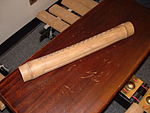| This article needs additional citations for verification. Please help improve this article by adding citations to reliable sources. Unsourced material may be challenged and removed. Find sources: "Bamboo musical instruments" – news · newspapers · books · scholar · JSTOR (August 2023) (Learn how and when to remove this message) |


Bamboo's natural hollow form makes it an obvious choice for many musical instruments. In South and South East Asia, traditional uses of bamboo the instrument include various types of woodwind instruments, such as flutes, and devices like xylophones and organs, which require resonating sections. In some traditional instruments bamboo is the primary material, while others combine bamboo with other materials such as wood and leather.
Overview
Bamboo has been used to create a variety of instruments including flutes, mouth organs, saxophones, trumpets, drums and xylophones.
Flutes
There are numerous types of bamboo flutes made all over the world, such as the dizi, xiao, shakuhachi, palendag and jinghu. In the Indian subcontinent, it is a very popular and highly respected musical instrument, available even to the poorest and the choice of many highly venerated maestros of classical music. It is known and revered above all as the divine flute forever associated with Lord Krishna, who is always portrayed holding a bansuri in sculptures and paintings. Four of the instruments used in Polynesia for traditional hula are made of bamboo: nose flute, rattle, stamping pipes and the jaw harp. Bamboo may be used in the construction of the Australian didgeridoo instead of the more traditional eucalyptus wood.
Other bamboo instruments
In Indonesia and the Philippines, bamboo has been used for making various kinds of musical instruments, including the kolintang, angklung and bumbong. Bamboo is also used to make slit drums. Traditional Philippine bamboo ensemble use a variety of bamboo musical instruments, including the marimba, angklung, panpipes and bumbong, as well as bamboo versions of western instruments, such as clarinets, saxophones, and tubas. The Las Piñas Bamboo Organ in the Philippines has pipes made of bamboo culms. The modern amplified string instrument, the Chapman stick, is also constructed using bamboo. The khene (also spelled khaen, kaen and khen; Lao: ແຄນ, Thai: แคน) is a mouth organ of Lao origin whose pipes, which are usually made of bamboo, are connected with a small, hollowed-out hardwood reservoir into which air is blown, creating a sound similar to that of the cello. In the Indian Ocean island of Madagascar, the valiha, a long tube zither made of a single bamboo stalk, is considered the national instrument.
Bamboo has also recently been used for the manufacture of guitars and ukuleles. Bamboo Ukuleles are constructed of solid cross laminated bamboo strips not plywood. The bamboo solid wood strips are similar to bamboo manufactured flooring.
Gallery
-
 Top and bottom-side views of a shakuhachi, end-blown bamboo flutes from Japan
Top and bottom-side views of a shakuhachi, end-blown bamboo flutes from Japan
-
Toka, bamoo clapper, Assam, Nepal
-
 Bamboo tanggetang tube zither, Sumatra
Bamboo tanggetang tube zither, Sumatra
-
 Bamboo tube-zither drum
Bamboo tube-zither drum
-
 Bamboo tube-zither drum
Bamboo tube-zither drum
-
 Bamboo gong or slit drum, Agung a tamlang, Philippines
Bamboo gong or slit drum, Agung a tamlang, Philippines
-
 Indonesian slit drum
Indonesian slit drum
-
 Sasando tube zither
Sasando tube zither
-
 Bamboo half-tube zithers
Bamboo half-tube zithers
-
 Double-reed clarinet, North Africa
Double-reed clarinet, North Africa
-
 Magruna double reed clarinet, Libya
Magruna double reed clarinet, Libya
-
 Bamboo trumpet, Sulawesi, Indonesia
Bamboo trumpet, Sulawesi, Indonesia
-
 Siku, Pan pipes, Bolivia or Peru, Andes Mountains
Siku, Pan pipes, Bolivia or Peru, Andes Mountains
-
 Pan pipes, New Ireland Province, Queensland, Australia
Pan pipes, New Ireland Province, Queensland, Australia
-
 bamboo Jew's Harp
bamboo Jew's Harp
-
 Ainu Jew's Harpo
Ainu Jew's Harpo
-
 Bali Indonesia Xylophone-player, photo by CEphoto, Uwe Aranas
Bali Indonesia Xylophone-player, photo by CEphoto, Uwe Aranas
-
 Bala, African xylophone
Bala, African xylophone
-
 Bamboo marimba, one of the instruments created by Harry Partch
Bamboo marimba, one of the instruments created by Harry Partch
-
 bamboo flutes
bamboo flutes
-
 Bansuri, Indian Subcontinent
Bansuri, Indian Subcontinent
-
 Sáo, Vietnamese flute
Sáo, Vietnamese flute
-
 Angklung, Indonesia
Angklung, Indonesia
-
 Kolintang xylophone and angklung, Indonesia
Kolintang xylophone and angklung, Indonesia
-
 Bamboo organ, Saint Joseph Parish Church, Las Piñas, Metro Manila, Philippine
Bamboo organ, Saint Joseph Parish Church, Las Piñas, Metro Manila, Philippine
-
 Bamboo saxophone, Argentina
Bamboo saxophone, Argentina
-
 Khene, mouth organ, Vietnam, Cambodia, Laos
Khene, mouth organ, Vietnam, Cambodia, Laos
-
Sheng mouth organ, China
-
 Lusheng mouth organ
Lusheng mouth organ
-
 Ploong, a musical instrument of the Mru people, Bangladesh
Ploong, a musical instrument of the Mru people, Bangladesh
-
 Jinghu, Chinese bowed string instrument
Jinghu, Chinese bowed string instrument
-
 Musician Agustinus Sasundu of Sangihe, with a bamboo wind instrument
Musician Agustinus Sasundu of Sangihe, with a bamboo wind instrument
References
- Mercurio, Philip Dominguez (2006). "Traditional Music of the Southern Philippines". PnoyAndTheCity: A center for Kulintang – A home for Pasikings. Retrieved June 12, 2006.
- "Origins and development of bamboo music". bbc.co.uk. 2011. Retrieved March 27, 2011.